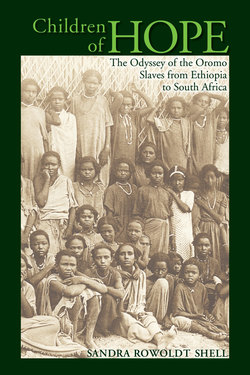Читать книгу Children of Hope - Sandra Rowoldt Shell - Страница 7
На сайте Литреса книга снята с продажи.
ОглавлениеIllustrations
Figures
1.1. Mountainous terrain between Axum and Lalibela in Ethiopia
1.2. Holy tree festooned with cloth and votive offerings for Oromo worship
1.3. Ancient walled city of Harar
2.1. Oromo children shortly after their arrival at the Keith-Falconer Mission
3.1. Oromo oxen
3.2. Cavalry on the Wadela plateau in Ethiopia
6.1. Billy King’s descent from highlands to coast
7.1. Cross section of a two-masted slave dhow
7.2. Gardner gun
7.3. Tadjoura in the mid-nineteenth century
7.4. Modern Rahayta/Raheita/Araito
7.5. Slave ship captured by HMS Osprey, ca. 1885
8.1. Aden in 1882
8.2. Oromo children on arrival at Sheikh Othman, September 1888
8.3. Reverend William Gardner at Sheikh Othman
8.4. Keith-Falconer School: boys on ground floor; girls on upper floor, 1889
8.5. Keith-Falconer Mission: Oromo children and missionaries
8.6. Berille Boko at Lovedale, ca. 1899
8.7. Oromo children at Sheikh Othman, 1890
9.1. Conway Castle, 1880
9.2. Fillis Circus poster for World’s Fair, Chicago, 1893
10.1. Oromo boys at Lovedale shortly after their arrival, ca. 1890
10.2. Oromo boys at Lovedale shortly after their arrival, ca. 1890 (same photo as 10.1, with Lochhead replaced by Alexander Geddes)
10.3. Oromo girls in their Sunday best at Lovedale, ca. 1892
10.4. Samuel Edward Krune Mqhayi
10.5. Berille Boko at Lovedale, ca. 1898
10.6. Bisho Jarsa at Lovedale, ca. 1898
10.7. Dr. Neville Alexander in 2008
11.1. Wreck of the König, East Africa, 1914
11.2. Ethiopian delegation at the coronation of Edward VII, 1902
11.3. Tolassa Wayessa at Lovedale
11.4. Kronprinz
11.5. Deck plan of the Kronprinz
A.1. Extract from Aguchello Chabani’s personal narrative
A.2. Extract from Aguchello Chabani’s entry in SPSS data form
Graphs
2.1. Ages of boys and girls when interviewed
2.2. Years of capture showing onset of drought, famine, and rinderpest
2.3. Family sizes of boys and girls
2.4. Orphanhood of the Oromo children vs. children in South Africa, Ethiopia, and Oromia
3.1. Parental occupation by gender of child
3.2. Relative sizes of land occupied by Oromo families
3.3. Family livestock ownership by gender of child
4.1. Altitude at which each child was captured
4.2. Altitudes of places of origin by gender of child
4.3. Home countries of the Oromo children
4.4. Ethnicities of the children
5.1. Places of origin of the children’s captors
5.2. Places of origin of raiders and of children
5.3. Modes of capture by gender of child
5.4. Domestic and external slave trade networks
5.5. Occupations of captors
6.1. Final legs to entrepôts
6.2. Distances (km) from capture to coast: boys and girls
6.3. Distances (km) from capture to coast: boys
6.4. Distances (km) from capture to coast: girls
6.5. Travel times on the road: boys and girls
6.6. Years in domestic enslavement by gender of child
6.7. Total first-passage time in years from home to dhow
6.8. Ethnic identities of slave traders and owners
6.9. Changing hands
6.10. Attempted escapes by gender of child
10.1. Ages of Oromo children on arrival at Lovedale, 1890
10.2. Class marks in percentages at Lovedale, 1880–1890
10.3. Distribution of class marks for Oromo and non-Oromo scholars by gender
10.4. Marks of Oromo and other Lovedale scholars by gender
10.5. Oromo class positions
10.6. Mortality of the Oromo boys
10.7. Mortality of the Oromo girls
10.8. Mortality rates of Oromo and non-Oromo students, 1891–1899
11.1. Results of Lovedale’s 1903 repatriation poll
A.1. Bird’s-eye view of the classification of variables
Maps
1.1. Modern Ethiopian administrative regions
1.2. Reclus’s population figures overlaid on a modern outline map of Ethiopia
4.1. Places of domicile of the Oromo captives
6.1. Two entrepôts and penultimate points of call
6.2. Crisscrossed journeys of the sixty-four Oromo children
7.1. Perim Island in the Strait of Mandeb
9.1. Sea voyage from Aden, Yemen, to East London, South Africa
9.2. Route from East London to Lovedale
11.1. Arena of Buller’s forces in Natal, January–July 1900
11.2. Bismarck’s dream of a German Mittelafrika
11.3. Domiciles of the Oromo in South Africa by 1909
Maps of Oromo Children’s Slave Routes
Males
B.1. Aguchello Chabani
B.2. Amanu Bulcha
B.3. Amanu Figgo
B.4. Amaye Tiksa
B.5. Badassa Nonno
B.6. Badassa Wulli
B.7. Baki Malakka
B.8. Balcha Billo
B.9. Bayan Liliso
B.10. Daba Tobo
B.11. Faraja Lalego
B.12. Faraja Jimma
B.13. Fayissa Hora
B.14. Fayissa Murki
B.15. Fayissa Umbe
B.16. Gaite Goshe
B.17. Galgal Dikko
B.18. Gamaches Garba
B.19. Gilo Kashe
B.20. Gutama Tarafo
B.21. Guyo Tiki
B.22. Hora Bulcha
B.23. Isho Karabe
B.24. Katshi Wolamo
B.25. Kintiso Bulcha
B.26. Komo Gonda
B.27. Liban Bultum
B.28. Milko Guyo
B.29. Mulatta Billi
B.30. Nagaro Chali
B.31. Nuro Chabse
B.32. Rufo Gangila
B.33. Sego Oria
B.34. Shamo Ayanso
B.35. Tola Abaye
B.36. Tola Lual
B.37. Tola Urgessa
B.38. Tolassa Wayessa
B.39. Wakinne Nagesso
B.40. Wayessa Gudru
B.41. Wayessa Tikse
B.42. Wayessa Tonki
Females
B.43. Agude Bulcha
B.44. Asho Sayo
B.45. Ayantu Said
B.46. Berille Boko
B.47. Berille Nehor
B.48. Bisho Jarsa
B.49. Damuli Diso
B.50. Damuli Dunge
B.51. Dinkitu Boensa
B.52. Fayissi Gemo
B.53. Galani Warabu
B.54. Galgalli Shangalla
B.55. Halko Danko
B.56. Hawe Sukute
B.57. Jifari Roba
B.58. Kanatu Danke
B.59. Meshinge Salban
B.60. Soye Sanyacha
B.61. Turungo Gudda
B.62. Turungo Tinno
B.63. Wakinni Ugga
B.64. Warkitu Galatu
Tables
7.1. Details of three dhows intercepted by HMS Osprey
10.1. Comparative crude death rates, 1891–1901
11.1. Confirmed independent and Kronprinz repatriates
A.1. Changing sex ratios
C.1. Place-names and alternatives mentioned by Oromo children
